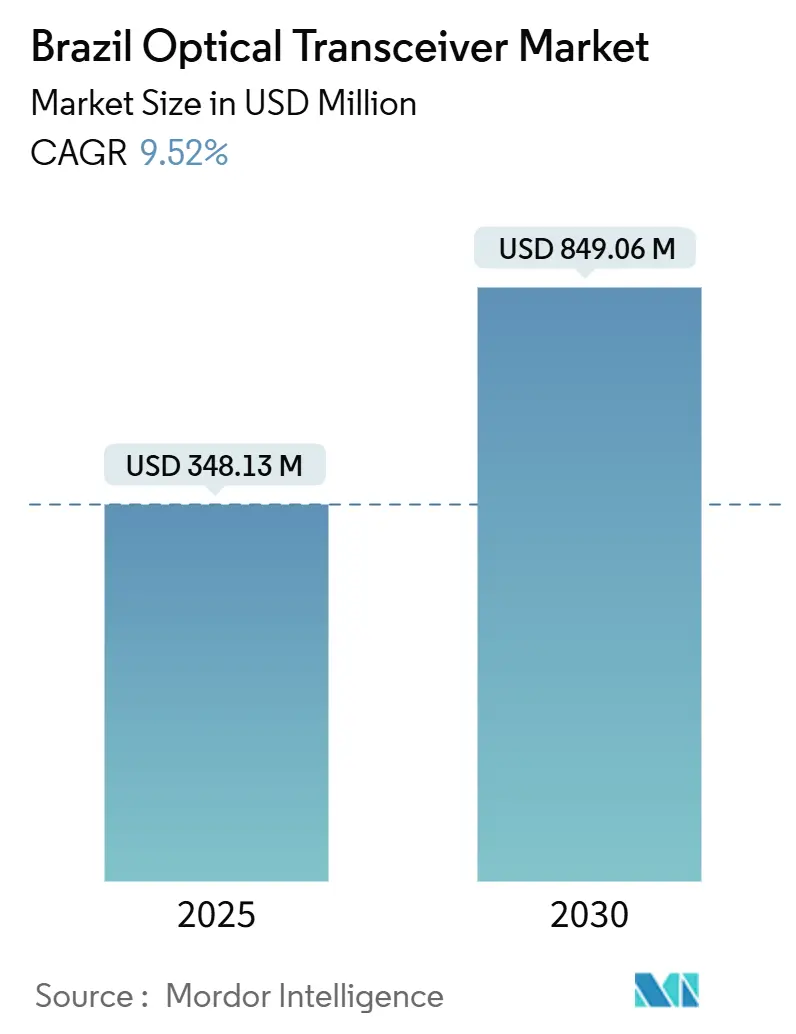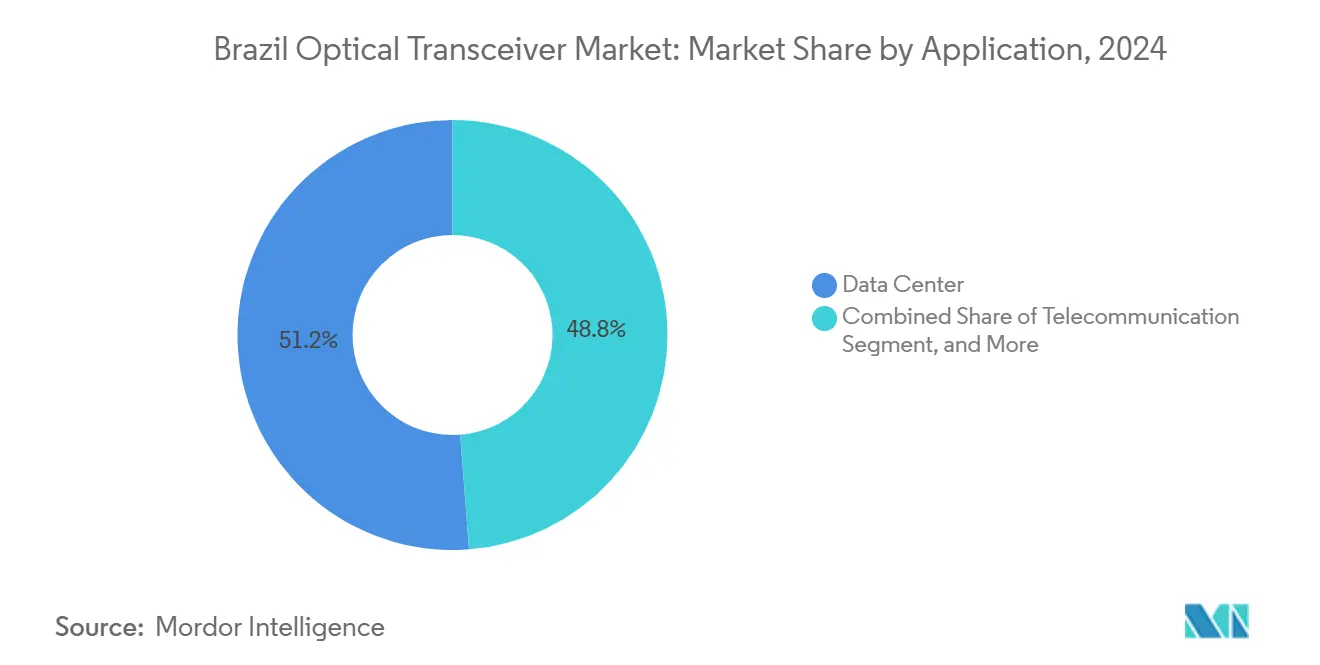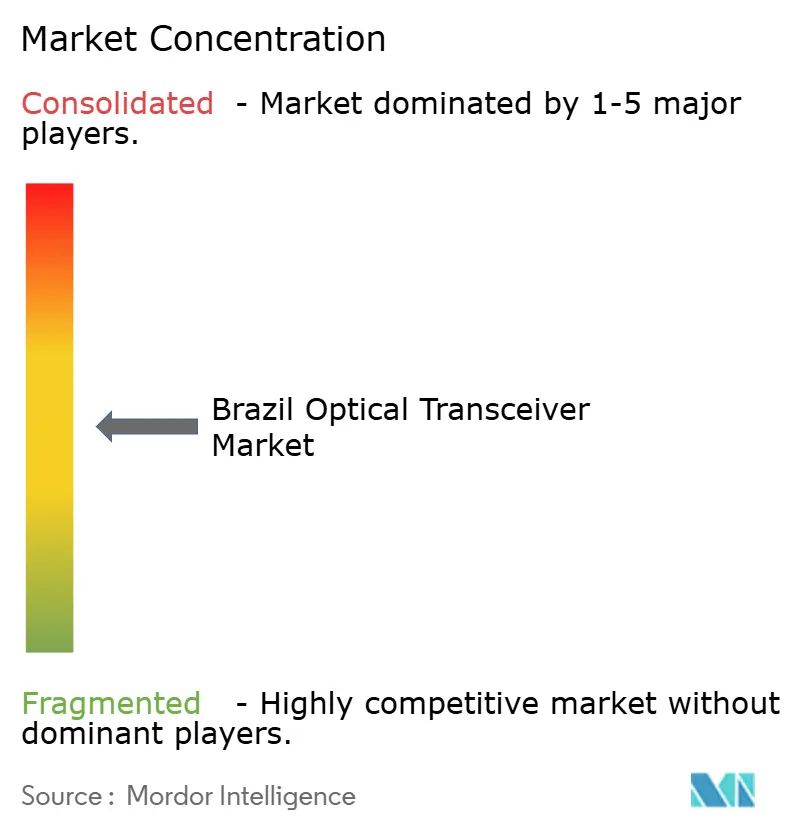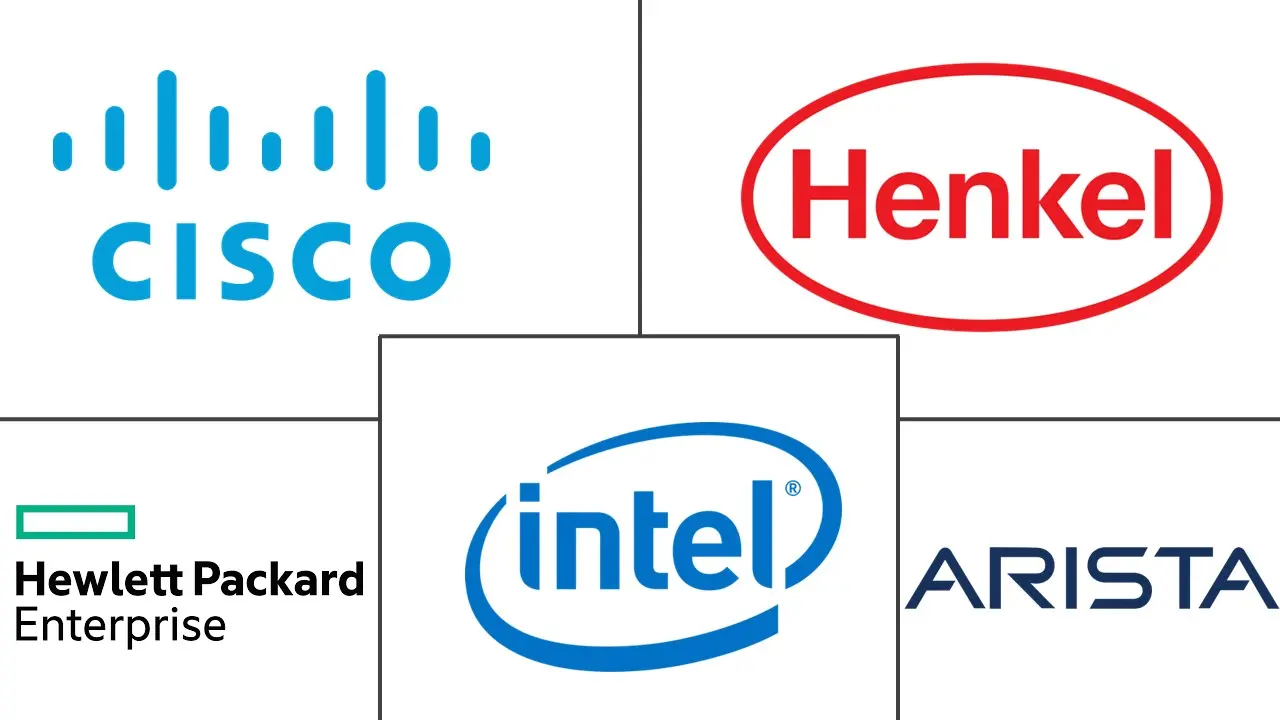Brazil Optical Transceiver Market Size and Share

Brazil Optical Transceiver Market Analysis by Mordor Intelligence
The Brazil optical transceiver market size reached USD 348.13 million in 2025 and is projected to advance to USD 849.6 million by 2030, translating into a 9.52% CAGR over the forecast period. Cloud operators are moving quickly to 400G and 800G interfaces, telecom carriers are densifying 25G backhaul, and public incentives for local assembly are tempering the impact of rising import tariffs. Fortaleza’s position as an international landing hub adds further momentum, while private 5G licenses are opening fresh enterprise and industrial demand pockets. Supply chain vulnerability around photonic integrated circuits and talent shortages in coherent optics remain headwinds, yet sustained capital outlays by hyperscale, telecom, and utility stakeholders keep the growth outlook solid for the Brazil optical transceiver market.
Key Report Takeaways
- By protocol, Ethernet held 46.11% revenue share of the Brazil optical transceiver market in 2024, while CWDM and DWDM protocols are forecast to expand at an 11.11% CAGR through 2030.
- By data rate, the 10-40 Gbps segment accounted for 39.54% share of the Brazil optical transceiver market size in 2024, whereas >100 Gbps transceivers are projected to grow at a 10.25% CAGR to 2030.
- By application, data centers led the Brazil optical transceiver market share at 51.22% in 2024; telecommunications are poised for the fastest CAGR at 10.79% through 2030.
- By connector type, SFP+ modules commanded 44.78% revenue share in 2024, and QSFP-DD is on track for the highest 11.57% CAGR to 2030.
Brazil Optical Transceiver Market Trends and Insights
Drivers Impact Analysis
| Driver | (~) % Impact on CAGR Forecast | Geographic Relevance | Impact Timeline |
|---|---|---|---|
| Rising hyperscale and colocation data center footprint | +2.10% | National, concentrated in São Paulo, Rio de Janeiro | Medium term (2-4 years) |
| 5G backhaul densification across Tier-1 MNOs | +1.80% | National, priority in metropolitan areas | Short term (≤ 2 years) |
| Government long-haul fiber backbone initiatives | +1.40% | National, emphasis on Amazon region | Long term (≥ 4 years) |
| PPB tax incentives for local optical assembly | +1.20% | National, manufacturing hubs in São Paulo, Manaus | Medium term (2-4 years) |
| Subsea-cable landing hub expansion in Fortaleza | +0.90% | Northeast region, international connectivity | Long term (≥ 4 years) |
| Smart-grid fiberization by electric utilities | +0.70% | National, transmission corridor focus | Long term (≥ 4 years) |
| Source: Mordor Intelligence | |||
Rising Hyperscale and Colocation Data Center Footprint
Brazil’s data center capacity stood at 538 MW in 2024 with another 672 MW announced, cementing the nation as Latin America’s prime cloud node. AWS earmarked BRL 10 billion (USD 1.8 billion) for new campuses around São Paulo, which already hosts 70% of Brazil’s internet traffic. Modern spine-leaf topologies demand dense 400G optics, and early pilots of 800G links for AI inference clusters are under way. Scala Data Centers and Microsoft’s regional partners are also scaling, ensuring steady, diversified orders for multimode and single-mode modules. With cloud tenants shifting to AI acceleration, the average switch-to-server bandwidth requirement is doubling every 18-24 months, making high-speed optical transceivers indispensable across primary and edge facilities in the Brazil optical transceiver market.
5G Backhaul Densification Across Tier-1 MNOs
National 5G coverage attained in December 2024 created a surge in fronthaul and midhaul build-outs. TIM Brazil alone activated 8,479 5G base stations, and Open RAN trials by Vivo and Nokia are migrating transport interfaces from 10G to 25G and 100G optics. Spectrum auction clauses oblige standalone architecture by 2025, forcing operators to replace legacy microwave with fiber in dense and rural clusters alike. Private 5G permits 66 as of mid-2025 extend optical demand into industrial parks, ports, and agribusiness sites. Resulting traffic growth is compressing upgrade cycles and elevating coherent pluggables for regional aggregation, adding meaningful volume upside for the Brazil optical transceiver market.
Government Long-Haul Fiber Backbone Initiatives
The Norte Conectado program calls for 15,000 km of sub-fluvial cable to bridge remote Amazon municipalities to the core network, requiring ultra-long-reach DWDM modules with low power-to-span performance. Parallel efforts include BNDES financing of BRL 40 million (USD 8 million) for Minas Gerais corridors and Defense Ministry upgrade worth BRL 6 million (USD 1.2 million). Cross-border infovia projects under Rotas de Integração Sul-Americana knit Brazil to neighbouring economies, expanding demand for 400G coherent optics. These initiatives progress over multiyear horizons, but tender structures guarantee minimum offtake, providing predictable demand signals to suppliers active in the Brazil optical transceiver market.
PPB Tax Incentives for Local Optical Assembly
The Processo Produtivo Básico regime slashes IPI duties by up to 95% for qualified local assembly, while ex-tarifário provisions suspend import levies on components without domestic equivalents, collectively boosting cost competitiveness for Brazil-built modules. The Manaus Free Trade Zone adds state-level incentives, and anti-dumping duties of 35% on imported Chinese optical cable tilt the economics further toward local value addition. Vendors that achieve PPB compliance win preferential scores in federal and utility procurements yet must invest in local engineering talent particularly scarce in coherent optics. Those prepared to build and certify facilities in São Paulo or Manaus are positioned to capture incremental share as the Brazil optical transceiver market scales.
Restraints Impact Analysis
| Restraint | (~) % Impact on CAGR Forecast | Geographic Relevance | Impact Timeline |
|---|---|---|---|
| High import tariffs and customs delays | -1.60% | National, ports of entry concentration | Short term (≤ 2 years) |
| Photonic-IC supply chain volatility | -1.20% | Global supply chain, local assembly impact | Medium term (2-4 years) |
| Shortage of coherent-optics engineering skills | -0.80% | National, concentrated in tech hubs | Long term (≥ 4 years) |
| Legacy copper metro networks in secondary cities | -0.60% | Secondary and tertiary cities | Long term (≥ 4 years) |
| Source: Mordor Intelligence | |||
High Import Tariffs and Customs Delays
In 2024 the tariff on finished optical cable rose to 35%, adding immediate cost pressure for module imports. Customs queues at Santos and Rio de Janeiro frequently extend clearance by up to 30 days, and ANATEL certification for new optics can stretch an additional 6-12 months. While ex-tarifário relief exists, applications take at least 90 days, complicating inventory planning. These frictions are prompting vendors to reroute volumes through PPB-compliant lines, but the capital outlay required for local assembly and test still limits scale in the near term, slowing some deployments within the Brazil optical transceiver market.
Photonic-IC Supply Chain Volatility
Eighty percent of advanced photonic ICs originate from Taiwanese and Singaporean fabs, exposing Brazilian buyers to geopolitical and natural-disaster risks. Lead times for specialty coherent chips doubled to 24 weeks during pandemic-era disruptions and remain vulnerable to shocks. Sea freight from Asia to Brazil averages 45-60 days, and limited air cargo space raises logistics costs for high-value components. Domestic R and D milestones, such as CPQD’s 1 Tbps chip, are promising yet still years from volume production. Consequently, supply chain fragility could intermittently squeeze availability and pricing, tempering upside for the Brazil optical transceiver market through mid-decade.
Segment Analysis
By Protocol: Ethernet Dominance Amid DWDM Acceleration
Ethernet protocols commanded 46.11% of 2024 revenue, anchoring the Brazil optical transceiver market through massive server-to-leaf connectivity in hyperscale campuses. Growing shipments of 400G Ethernet switches are sustaining high-volume SFP56-DD and QSFP-DD optics. Even so, DWDM and CWDM links are registering an 11.11% CAGR, pushed by long-haul projects such as Norte Conectado and burgeoning subsea routings into Fortaleza. The dual trajectory underscores how edge-cloud latency targets coexist with ultra-long-reach backbone requirements inside the Brazil optical transceiver market size estimates for the protocol segment.
Migration from legacy TDM to packet networks is nearly complete among tier-one carriers, and Open RAN blueprints adopt Ethernet fronthaul to simplify interoperability. Fibre Channel retains beachheads in mission-critical storage networks of banks and clearinghouses, yet its share is tapering. Other protocols, including 800G Ethernet and deterministic industrial interfaces, are emerging but remain marginal until standards stabilize. Overall, Ethernet will stay dominant, but coherent DWDM line sides will capture incremental value as digital inclusion expands deep-fiber reach across Brazil.

Note: Segment shares of all individual segments available upon report purchase
By Data Rate: High-Speed Migration Accelerates
The 10-40 Gbps category delivered 39.54% of 2024 shipments, reflecting the still-sizeable installed base of 10G aggregation and 25G access links. Rapid cloud traffic growth is lifting >100 Gbps modules at a 10.25% CAGR, however, and 400G ports already account for more than 50% of new switch leases among hyperscale tenants. That mix shift is enlarging the Brazil optical transceiver market size for high-end pluggable, while silicon photonics innovations are nudging price-per-bit down.
Sub-10 Gbps optics persist in cost-sensitive enterprise and industrial settings where bandwidth needs are modest. Yet AI training clusters, fintech latency arbitrage, and 5G standalone core interconnects are collectively tilting investments to 400G and 800G. Forecasts foresee early 1.6 Tbps test deployments after 2027, placing sustained pressure on supply chains to craft power-efficient, thermally robust form factors aligned with tropical data hall conditions in Brazil.
By Application: Telecommunications Surge Overtakes Data Centers
Data centers retained a 51.22% share in 2024 thanks to cloud hyperscalers and colocation operators, but telecom will register the fastest 10.79% CAGR as carriers finalize 5G backhaul densification. Almost every cell site upgrade to standalone 5G necessitates fiber reticulation and midhaul optics, elevating the fortunes of the Brazil optical transceiver market across mobile infrastructure deployments.
Enterprise and HPC networks continue to adopt 100G and 200G ports in financial services and academic research clusters, but their aggregate volume trails carrier and cloud spending. Industrial, medical, and EV system deployments are opening new verticals via private 5G licenses, requiring ruggedized optics that tolerate vibration and temperature extremes. Utilities likewise tap optical ground wire mandates to digitize substations, generating niche demand for hardened DWDM pluggable.

Note: Segment shares of all individual segments available upon report purchase
By Connector Type: QSFP-DD Emergence Challenges SFP+ Leadership
SFP+ dominated 2024 shipments at 44.78% thanks to reliable 10G and 25G economics in brownfield networks. The brisk adoption of 400G Ethernet, however, is propelling QSFP-DD volumes at an 11.57% CAGR, with hyperscalers favouring its high port density. That transition absorbs a rising share of the Brazil optical transceiver market size attached to connector innovation.
QSFP and QSFP28 remain relevant in 100G metro and data center inter-switch links, while CFP derivatives serve specialty long-haul roles, benefiting from larger thermal envelopes. OSFP is gaining limited traction in AI backplanes where power headroom permits, yet QSFP-DD is expected to be the mainstream 400G and 800G choice. XFP and CXP linger in legacy SAN gear but carry negligible future growth.
Geography Analysis
Demand clusters mainly in the Southeast, where São Paulo and Rio de Janeiro combine for roughly 60% of the Brazil optical transceiver market. Hyperscale footprints, fintech cores, and dense FTTH deployments converge here, and multiple internet exchanges incentivize high-capacity interconnects. The Brazil optical transceiver market share for the Northeast is climbing quickly as Fortaleza’s 16 active cable systems funnel 90% of inbound international traffic, spurring metro and long-haul optical upgrades around Ceará’s capital.
In the South, industrial automation in Paraná and Santa Catarina is accelerating fiberization of manufacturing corridors. Precision agriculture pilots in Rio Grande do Sul are also integrating optical backbones to support drone telemetry and IoT sensor arrays. Central-West connectivity expansion hinges on federal grants so that interior agribusiness hubs like Mato Grosso can bridge digital divides.
The North, while smallest today, carries the highest long-run upside. Norte Conectado’s 15,000 km Amazon backbone stages incremental bids for coherent DWDM optics through 2028. Optical demand in the region remains contingent on environmental permitting and logistics challenges, yet successful segments could lift the Brazil optical transceiver market size meaningfully once initial links go live.
Competitive Landscape
The competitive scene is moderately fragmented, as no vendor exceeds a 15% revenue share in Brazil. Global incumbents Cisco, Huawei, and Lumentum collectively held about 28% in 2024, while Nokia’s 2025 acquisition of Infinera enhances its coherent optics suite, elevating its profile for long-haul contracts tied to Norte Conectado. Ciena focuses on submarine and regional backbone upgrades centered on Fortaleza’s landing stations.
Local assembly is emerging as a differentiator. Padtec and Fiberhome’s Brazilian joint ventures advertise PPB-compliant lines that slash IPI duties, appealing to government and utility buyers with local-content preferences. Silicon photonics specialists such as MaxLinear, in collaboration with Jabil Manaus, are positioning 800G modules optimized for high ambient temperatures typical of tropical data halls.
Strategic partnerships are clustering around power-efficient transceivers. Hyperscalers are co-designing co-packaged optics with chipmakers to alleviate rack-level heat density. Telecom carriers are piloting open line systems that accept third-party pluggable, eroding lock-in and pressuring pricing. Supply chain resilience, demonstrated through secured photonic-IC allocations, is emerging as a key point of differentiation as the Brazil optical transceiver market expands.
Brazil Optical Transceiver Industry Leaders
-
Cisco Systems
-
Hewlett Packard Enterprise (HPE)
-
Arista Networks
-
Intel Corporation
-
Henkel AG & Co. KGaA
- *Disclaimer: Major Players sorted in no particular order

Recent Industry Developments
- January 2025: Nokia closed its USD 2.3 billion purchase of Infinera, creating a portfolio that spans metro through subsea coherent optics.
- December 2024: Brazil reached nationwide 5G coverage across all 5,570 municipalities, triggering sizable fiber backhaul orders.
- November 2024: AWS confirmed a BRL 10 billion (USD 1.8 billion) data center expansion in São Paulo focused on AI-ready 400G and 800G fabrics.
- October 2024: MaxLinear and Jabil revealed an 800G silicon-photonics module roadmap, targeting 2025 mass production.
Brazil Optical Transceiver Market Report Scope
An optical transceiver combines the functions of a transmitter and a receiver into a single device. Optical transceivers convert the electrical signal from a switch or router to an optical signal that can be transmitted and received in light pulses using fiber optic technology. This is accomplished at extremely high speeds and over large distances. It can be inserted in or implanted into another device that can send and receive data in a data network.
The Brazilian optical transceiver market is segmented by protocol (ethernet, fiber channels (including FTTx), CWDM/DWDM, and other protocols), data rate (less than 10 Gbps, 10 Gbps to 40 Gbps, 41 Gbps to 100 Gbps, greater than 100 Gbps (including 400 Gbps)), application (data center, telecommunication, and others). The market sizes and forecasts are provided in terms of value (USD) for the above segment.
| Ethernet |
| Fibre Channel (including FTTx) |
| CWDM/DWDM |
| Other Protocols |
| Less than 10 Gbps |
| 10 - 40 Gbps |
| 41 - 100 Gbps |
| More Than 100 Gbps (including 400 Gbps) |
| Data Center |
| Telecommunication |
| Enterprise and HPC Networks |
| Industrial, Medical and EV Systems |
| SFP and SFP+ |
| QSFP and QSFP-DD |
| CFP/CFP2/CFP4/OSFP |
| XFP and CXP |
| By Protocol | Ethernet |
| Fibre Channel (including FTTx) | |
| CWDM/DWDM | |
| Other Protocols | |
| By Data Rate | Less than 10 Gbps |
| 10 - 40 Gbps | |
| 41 - 100 Gbps | |
| More Than 100 Gbps (including 400 Gbps) | |
| By Application | Data Center |
| Telecommunication | |
| Enterprise and HPC Networks | |
| Industrial, Medical and EV Systems | |
| By Connector Type | SFP and SFP+ |
| QSFP and QSFP-DD | |
| CFP/CFP2/CFP4/OSFP | |
| XFP and CXP |
Key Questions Answered in the Report
What is the projected value of the Brazil optical transceiver market by 2030?
Forecasts point to USD 849.6 million by 2030, reflecting a 9.52% CAGR from 2025 levels.
Which protocol is expanding fastest in Brazil after 2024?
CWDM and DWDM links are set to grow at an 11.11% CAGR, outpacing Ethernet's mature base.
How will 5G influence optical module demand in Brazil?
Nationwide 5G coverage is driving dense fiber backhaul and fronthaul, lifting telecom optical needs at a 10.79% CAGR to 2030.
Which connector type is gaining the most popularity for 400G and 800G deployments?
QSFP-DD is the fastest-growing interface, posting an 11.57% CAGR as hyperscale operators transition to high-density 400G and 800G switches.
What incentives encourage local assembly of optical transceivers in Brazil?
The Processo Produtivo Básico framework cuts IPI tax by up to 95% for qualifying local production, while ex-tarifário provisions suspend duties on non-manufactured components.
How fragmented is supplier competition in Brazil?
The top five vendors hold about 45% of revenue, signaling moderate concentration with ample room for niche and local entrants.
Page last updated on:



